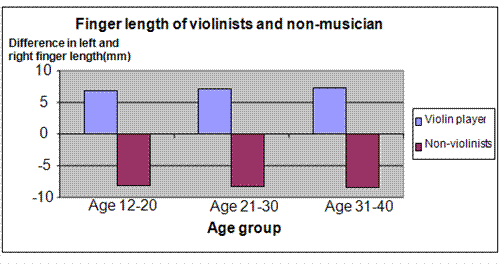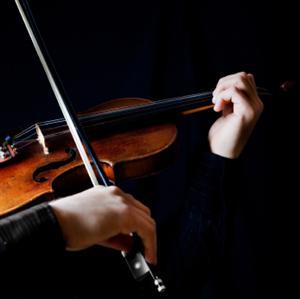| Complexity level: | 7 |
| Project cost ($): | 5 |
| Time required: | 1 hour to prepare, 1 day for the science project experiment |
| Material availability: | Requires the participation of violinists. Try approaching members of an orchestra or string ensemble. |
| Safety concerns: | None |
Hypothesis
Violinists have longer fingers on their left hand, while non-violinists will have shorter fingers on their left hand. We base our hypothesis on the fact that a violin is normally held and fingered with the left hand (the right hand is used for bowing), and the assumption that the frequent movement of a violinists fingers on the left hand, will result in accelerated growth and hence, longer fingers.
Overview
Bones
Bones are a form of specialized tissue. They are very strong and durable. Bones in our body will elongate and grow starting from the time we are born until adolescence. The rate of development of our bones will also depend on, amongst other things, the amount of nutrition, exercise and exposure to sunlight. Sunlight helps us produce vitamin D - which is important for absorbing calcium.
Our bones provide the frame and structural support required to hold our flesh, organs and muscles together. They also provide protection for our vital organs. For example the ribcage protects the heart and lungs, while the skull protects our brains. Bone marrow found at the core of our bones, is used to produce blood cells and to store fat. Bones also act as a reservoir for calcium storage.
Scientific Terms
Materials
The materials required for this science fair project:
- 10 participants 12 to 20 years old who have played the violin for at least 5 years
- 10 participants 21 to 30 years old who have played the violin for at least 5 years
- 10 participants 31 to 40 years old who have played the violin for at least 5 years
- 10 participants 12 to 20 years old who are non-violinists
- 10 participants 21 to 30 years old who are non-violinists
- 10 participants 31 to 40 years old who are non-violinists
- 1 ruler
- 1 wooden block
Procedure
1. For this science fair project, the independent variable is the age of the participants and whether or not they have played the violin for at least 5 years. The dependent variable is the difference in the length of their left and right fingers. This is determined by measuring the length of their fingers using the ruler and wooden block. The constants (control variables) are the number of years for which they have played the violin and the method used to measure the length of the fingers.
2. Sixty participants are required for this science fair project out of which 30 participants are required to have played the violin for at least 5 years and the remaining 30 participants are non-musicians. Out of the 30 participants, 10 of them will be from each of the age groups 12 to 20 years, 21 to 30 years and 31 to 40 years old.
3. The length of the participant’s index, middle, ring and little fingers are measured on the left and right hand. The measurements are taken by placing a wooden block at the tip of the finger and using the ruler to measure the distance from the base of the finger to the edge of the wooded block.
4. The difference in length between the left fingers and right fingers is calculated as follows:
Finger length difference = Length of left finger (index) – Length of right finger (index)
The measurement is compared between the same fingers, i.e. left index to right index finger.
5. The differences in finger lengths are recorded. After completing the measurements for all 60 participants, the average difference in finger length for each group is obtained by totaling the differences in finger length, and dividing the total by 10. The finger measurement which shows the most significant difference is used and the calculated results are recorded in the table given below.

Results
It was observed that violinists have longer left fingers than their right fingers by about 7mm. Non-musicians have longer right fingers compared to their left fingers by about 8mm. Their age did not make a significant difference in finger length.
|
Condition |
Difference in left and right finger length for different age groups (mm) |
||
|
Age 12-20 |
Age 21-30 |
Age 31-40 |
|
|
Violin players |
6.8 |
7.1 |
7.2 |
|
Non-violin players |
-8.1 |
-8.4 |
-8.5 |
The graph below represents the results of our science project:

Conclusion
The hypothesis that violinists have longer fingers on their left hands, while non-violinists have shorter left hand fingers, is proven to be true.
Bones are a vital part of our body for many reasons. Involvement in sports and activities that result in stress on our bones, like baseball or playing musical instruments, are believed to increase the length and size of our bones.
Also consider
What would happen if the science project was repeated by comparing the finger length of musicians who play other instruments like the guitar or piano?
Try repeating this science project by measuring the arm length of baseball pitchers.
References
Bone lengthening in response to stress - http://thequestforheight.blogspot.com/2010/04/bone-lengthening-in-response-to-stress.html
Do string players have longer left fingers? - http://www.sciencebuddies.org/science-fair-projects/project_ideas/Music_p014.shtml
Basic bone biology - http://www.iofbonehealth.org/health-professionals/about-osteoporosis/basic-bone-biology.html

